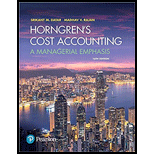
Concept explainers
Direct manufacturing labor variances: price, efficiency, mix, and yield. Elena Martinez employs two workers in her wedding cake bakery. The first worker, Gabrielle, has been making wedding cakes for 20 years and is paid $25 per hour. The second worker, Joseph, is less experienced and is paid $15 per hour. One wedding cake requires, on average, 6 hours of labor. The budgeted direct manufacturing labor quantities for one cake are as follows:
| Quantity | |
| Gabrielle | 3 hours |
| Joseph | 3 hours |
| Total | 6 hours |
That is, each cake is budgeted to require 6 hours of direct manufacturing labor, composed of 50% of Gabrielle’s labor and 50% of Joseph’s, although sometimes Gabrielle works more hours on a particular cake and Joseph less, or vice versa, with no obvious change in the quality of the cake.
During the month of May, the bakery produces 50 cakes. Actual direct
| Gabrielle (140 hours) | $ 3,500 |
| Joseph (165 hours) | 2,475 |
| Total actual direct labor cost | $ 5,975 |
- 1. What is the budgeted cost of direct manufacturing labor for 50 cakes?
Required
- 2. Calculate the total direct manufacturing labor price and efficiency variances.
- 3. For the 50 cakes, what is the total actual amount of direct manufacturing labor used? What is the actual direct manufacturing labor input mix percentage? What is the budgeted amount of Gabrielle’s and Joseph’s labor that should have been used for the 50 cakes?
- 4. Calculate the total direct manufacturing labor mix and yield variances. How do these numbers relate to the total direct manufacturing labor efficiency variance? What do these variances tell you?
Want to see the full answer?
Check out a sample textbook solution
Chapter 7 Solutions
EBK HORNGREN'S COST ACCOUNTING
- Compute the net income or net loss for the month ended on March 31, 2008, from the following data: Assets on March 1, 2008 $ 40,000 Liabilities on March 1, 2008, 30,000 Capital on March 31, 2008, 15,000 Additional investments by the owner during the year 2008 2,000 Withdrawals during the year 2008 1,000 A. $3,000 B. $4,000 C. $5,000 D. $6,000arrow_forwardMountain Bikes purchased 100 units at $200 each on January 1. On January 15, they purchased 150 units at $220 each. If they sold 180 units during January, calculate the ending inventory value using FIFO method.arrow_forwardPlease given correct answer general accountingarrow_forward
- What is the project expected free cash flow for the year? General accountingarrow_forwardNO WARONG ANSWERarrow_forwardA company sold office furniture costing $12,700 with accumulated depreciation of $10,150 for $2,200 cash. The entry to record the sale would include a gain or loss of what amount?arrow_forward
 Cornerstones of Cost Management (Cornerstones Ser...AccountingISBN:9781305970663Author:Don R. Hansen, Maryanne M. MowenPublisher:Cengage Learning
Cornerstones of Cost Management (Cornerstones Ser...AccountingISBN:9781305970663Author:Don R. Hansen, Maryanne M. MowenPublisher:Cengage Learning Managerial AccountingAccountingISBN:9781337912020Author:Carl Warren, Ph.d. Cma William B. TaylerPublisher:South-Western College Pub
Managerial AccountingAccountingISBN:9781337912020Author:Carl Warren, Ph.d. Cma William B. TaylerPublisher:South-Western College Pub Financial And Managerial AccountingAccountingISBN:9781337902663Author:WARREN, Carl S.Publisher:Cengage Learning,
Financial And Managerial AccountingAccountingISBN:9781337902663Author:WARREN, Carl S.Publisher:Cengage Learning,


